初三英语 早读资料
外研版初中九年级上册英语 Module 4【早读手册】 Unit 1 早读手册

Module 4 Home aloneUnit 1➢重点单词1. platform n.(供上下火车用的)月台;站台2. meeting n.会议;集会3. miss v.未出席;未出现4. shut v.关上;合上5. lock v.锁;锁住6. simple adj.简单的;容易的7. anybody pron.任何人8. clock n.钟;时钟9. ring v.鸣响;发出铃声【新义:n. 戒指 v.给……打电话】10. passenger n.乘客;旅客11. address n.地址【新义:n.演讲;演说 v.致函;向……说】12. text n.文本;正文13. couple n.一对;两个➢词形变换1. shut v.关上;合上过去式 shut 过去分词 shut2. simple adj.简单的;容易的 simply adv.简单地3. ring v.鸣响;发出铃声过去式 rang 过去分词 rung4. advise v.劝告;建议 advice n.建议;劝告;忠告➢重点短语1. text message 短信2. a couple of 两个3. be careful with 小心……4. make sure 确保➢重点句型1. 我也是(很遗憾),但是我不能两周不上课。
So am I, but I can’t miss two weeks of school.2. 尽管那对我来说并不容易,但我能照顾自己。
I can look after myself, although it won’t be easy for me.3. 我的闹钟很响,它肯定能把我叫醒。
My clock rings so loudly that it will certainly wake me up.。
人教英语九年级全一册Unit 10晨读本
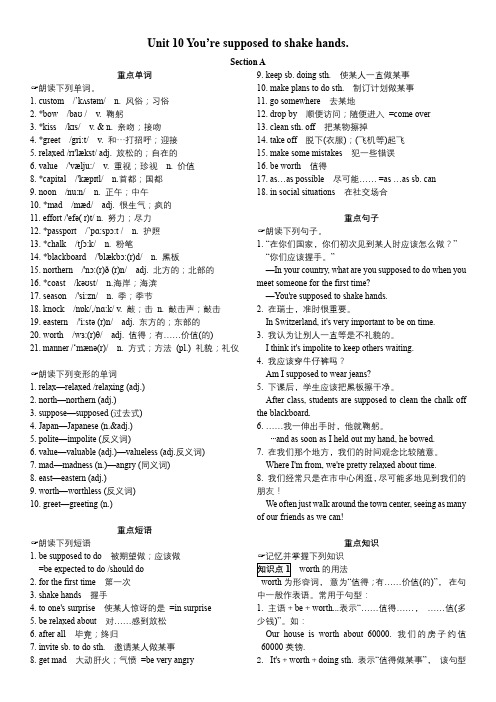
Unit 10 You’re supposed to shake hands.Section A重点单词✍朗读下列单词。
1. custom /’kʌstəm/ n. 风俗;习俗2. *bow /baʊ / v. 鞠躬3. *kiss /kɪs/ v. & n. 亲吻;接吻4. *greet /gri:t/ v. 和⋯⋯打招呼;迎接5. relaxed /rɪ'lækst/ adj. 放松的;自在的6. value /'vælju:/ v. 重视;珍视n. 价值8. *capital /'kæpɪtl/ n.首都;国都9. noon /nu:n/ n. 正午;中午10. *mad /mæd/ adj. 很生气;疯的11. effort /'efə( r)t/ n. 努力;尽力12. *passport /’pɑ:spɔ:t / n. 护照13. *chalk /tʃɔ:k/ n. 粉笔14. *blackboard /'blækbɔ:(r)d/ n. 黑板15. northern /'nɔ:(r)ð (r)n/ adj. 北方的;北部的16. *coast /kəʊst/ n.海岸;海滨17. season /'si:zn/ n. 季;季节18. knock /nɒk/,/nɑ:k/ v. 敲;击n. 敲击声;敲击19. eastern /'i:stə (r)n/ adj. 东方的;东部的20. worth /wɜ:(r)θ/ adj. 值得;有……价值(的)21. manner /‘mænə(r)/ n. 方式;方法(pl.) 礼貌;礼仪✍朗读下列变形的单词1. relax—relaxed /relaxing (adj.)2. north—northern (adj.)3. suppose—supposed (过去式)4. Japan—Japanese (n.&adj.)5. polite—impolite (反义词)6. value—valuable (adj.)—valueless (adj.反义词)7. mad—madness (n.)—angry (同义词)8. east—eastern (adj.)9. worth—worthless (反义词)10. greet—greeting (n.)重点短语✍朗读下列短语1. be supposed to do被期望做;应该做=be expected to do /should do2. for the first time第一次3. shake hands握手4. to one's surprise使某人惊讶的是=in surprise5. be relaxed about对……感到放松6. after all毕竟;终归7. invite sb. to do sth.邀请某人做某事8. get mad大动肝火;气愤=be very angry 9. keep sb. doing sth.使某人一直做某事10. make plans to do sth.制订计划做某事11. go somewhere去某地12. drop by顺便访问;随便进入=come over13. clean sth. off把某物擦掉14. take off脱下(衣服);(飞机等)起飞15. make some mistakes犯一些错误16. be worth值得17. as…as possible尽可能…… =as …as sb. can18. in social situations在社交场合重点句子✍朗读下列句子。
外研版初中九年级上册英语 Module 10【早读手册】 Unit 1 早读手册
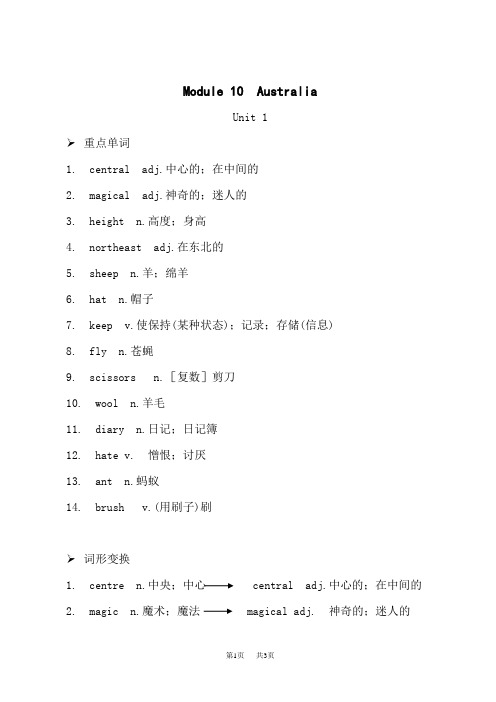
Module 10 AustraliaUnit 1➢重点单词1. central adj.中心的;在中间的2. magical adj.神奇的;迷人的3. height n.高度;身高4. northeast adj.在东北的5. sheep n.羊;绵羊6. hat n.帽子7. keep v.使保持(某种状态);记录;存储(信息)8. fly n.苍蝇9. scissors n.[复数]剪刀10. wool n.羊毛11. diary n.日记;日记簿12. hate v. 憎恨;讨厌13. ant n.蚂蚁14. brush v.(用刷子)刷➢词形变换1. centre n.中央;中心 central adj.中心的;在中间的2. magic n.魔术;魔法 magical adj. 神奇的;迷人的3. high adj.高的 height n.高度;身高4. sheep n.羊;绵羊复数 sheep➢重点短语1. English-speaking country 讲英语的国家2. here we go 我们这就看看3. be famous for 因……而著名4. according to 根据;按照;据……所说5. sailing boat 帆船6. lie off 相隔;相离7. come/be from来自8. keep a diary写日记9. all over 到处;遍及10. at the time 那时;在那段时间➢重点句型1. 我的老师让我们挑选一个我们想去游览的国家……My teacher asked us to choose a country we want to visit…2. 他们戴着驱赶苍蝇的特殊的帽子。
They wear special hats that keep the flies away.3. 他们拿着的剪刀是用来剪羊毛的。
The scissors that they’re holding are used to cut the wool off the sheep.4. 那就是他们说英语的原因。
外研版初中九年级上册英语 Module 9【早读手册】 Unit 1 早读手册
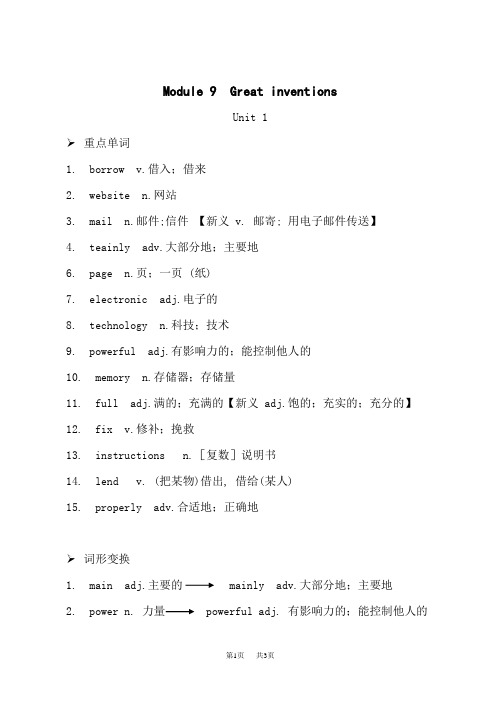
Module 9 Great inventionsUnit 1➢重点单词1. borrow v.借入;借来2. website n.网站3. mail n.邮件;信件【新义 v. 邮寄; 用电子邮件传送】4. teainly adv.大部分地;主要地6. page n.页;一页 (纸)7. electronic adj.电子的8. technology n.科技;技术9. powerful adj.有影响力的;能控制他人的10. memory n.存储器;存储量11. full adj.满的;充满的【新义 adj.饱的;充实的;充分的】12. fix v.修补;挽救13. instructions n.[复数]说明书14. lend v. (把某物)借出, 借给(某人)15. properly adv.合适地;正确地➢词形变换1. main adj.主要的 mainly adv.大部分地;主要地2. power n. 力量 powerful adj. 有影响力的;能控制他人的3. lend v. (把某物)借出,借给 (某人) 反义词 borrowv. 借入;借来4. proper adj. 合适的;适当的 properlyadv.合适地;正确地➢重点短语1. take photos 照相2. put up 张贴;公布3. on the Internet 在网上4. wait for 等待5. hear from 收到……的来信6. in the future 在将来7. in the past 在过去8. thousands of 好几千;成千上万9. electronic technology 电子技术10. memory card 存储卡11. take (good) care of (好好)照顾➢重点句型1. 它们将被公布在学校的网站上。
They’ll be put up on the school website.2. 那可以解决。
英语高分突破早读材料9年级

英语高分突破早读材料9年级1、Last year Polly _______ an English club and has improved her English a lot. [单选题] *A. leftB. sawC. joined(正确答案)D. heard2、59.—Can I talk to the manager?—Please wait ________ minute. [单选题] * A.anB.a(正确答案)C.theD./3、Don’t read in bed. It’s _______ your eyes. [单选题] *A. good atB. good forC. bad atD. bad for(正确答案)4、This seat is vacant and you can take it. [单选题] *A. 干净的B. 没人的(正确答案)C. 舒适的D. 前排的5、1——May I help you? You seem to be having some problems.——_______ , thanks. Ithink I can manage. [单选题] *A. All rightB. No problemC. It’s all right(正确答案)D. There’s no way6、94.—Let’s go out for a picnic on Sunday.—________. [单选题] *A.Nice to meet youB.Here you areC.The same to youD.Good idea(正确答案)7、57.Next week will be Lisa's birthday. I will send her a birthday present ________ post. [单选题] *A.withB.forC.by(正确答案)D.in8、_____ the project, we'll have to work two more weeks. [单选题] *A. CompletingB. CompleteC. Having completedD.To complete(正确答案)9、When Max rushed to the classroom, his classmates _____ exercises attentively. [单选题] *A. didB. have doneC. were doing(正确答案)D. do10、40.Star wars is ______ adventure film and it is very interesting. [单选题] *A.aB.an (正确答案)C.theD./11、“I think you are wonderful,”she said, “You are so patient with your little George.”[单选题] *A. 耐心(正确答案)B. 细心C. 关心D. 偏心12、27.Will it ______ warm in the room? [单选题] *A.areB.be(正确答案)C.isD.going to be13、A good teacher is able to_____a complicated idea in very simple terms. [单选题] *A.put across(正确答案)B.break upC.work outD.bring out14、While studying abroad, he financially depended()his wife. [单选题] *A. on(正确答案)B. ofC. toD. from15、Don’t forget _______ those books when you are free. [单选题] *A. to read(正确答案)B. readingC. readD. to reading16、They lost their way in the forest, and _____ made matters worse was night began to fall. [单选题] *A. thatB. itC. what(正确答案)D. which17、What _______ would you like, sir? [单选题] *A. otherB. else(正确答案)C. othersD. another18、The office building will be _______ a library. [单选题] *A. turned onB. turned upC. turned into(正确答案)D. turned off19、He always did well at school _____ having to do part-time jobs every now and then. [单选题] *A despite ofB. in spite of(正确答案)C. regardless ofD in case of20、Sorry, I can't accept your invitation. [单选题] *A. 礼物B. 观点C. 邀请(正确答案)D. 好意21、I knocked on the door but _______ answered. [单选题] *A. somebodyB. anybodyC. nobody(正确答案)D. everybody22、We all wondered()Tom broke up with his girlfriend. [单选题] *A. thatB. whatC. whoD. why(正确答案)23、As I know, his salary as a doctor is much higher_____. [单选题] *A. than that of a teacher(正确答案)B. than a teacherC. to that of a teacherD. to a teacher24、_____, Martin can reach the branch of that tall tree at the gate. [单选题] *A. As a short manB. Being shortC. As he is shortD. Short as he is(正确答案)25、The little boy saved his money ______ he could buy his mother a gift on Mother’s Day.()[单选题] *A. butB. such thatC. in order toD. so that(正确答案)26、Miss Smith is a friend of _____. [单选题] *A. Jack’s sister’s(正确答案)B. Jack’s sisterC. Jack sister’sD. Jack sister27、--Jenny, what’s your favorite _______?--I like potatoes best. [单选题] *A. fruitB. vegetable(正确答案)C. drinkD. meat28、So many people will _______ to their work after the Spring Festival. [单选题] *A. get inB. get onC. get offD. get back(正确答案)29、______ in the library. ()[单选题] *A. Don’t smokingB. No smokeC. No smoking(正确答案)D. Doesn’t smoke30、Kate has a cat _______ Mimi. [单选题] *A. called(正确答案)B. callC. to callD. calling。
人教版九年级英语Unit 4晨读本

Unit 4 I used to be afraid of the dark.Section A重点单词✍朗读下列单词。
1. *humorous /hju:mərəs/ adj.有幽默感的;滑稽的2. silent /'saɪlənt/ adj. 不说话的;沉默的3. helpful /'helpfl/ adj. 有用的;有帮助的4. *score /skɔ:( r)/ n. & v. 得分;打分5. *background /'bækgraʊnd/ n. 背景6. *interview /'ɪntə (r)vju:/ v. 采访;面试n. 访谈7. *Asian /'eɪʃn/,/'eɪʒn/ a. 亚洲(人)的;n. 亚洲人8. deal /di:l/ v. 对付;对待8. shyness /'ʃaɪnəs/ n. 害羞;腼腆9. dare /deə/,/der/ v. 敢于;胆敢10. *crowd /kraʊd/ n. 人群;观众11. ton /tʌn/ n. 吨;(pl)大量;许多12. private /'praɪvət/ adj. 私人的;私密的13. *guard /gɑ:(r)d/ n. 警卫;看守v. 守卫;保卫14. require /rɪ'kwaɪə(r)/ v. 需要;要求15. *European /jʊ(ə)rə'pi:ən/ adj. 欧洲(人)的n. 欧洲人16. *African /'æfrɪkən/ adj. 非洲(人)的n. 非洲人17. *British /'brɪtɪʃ/ adj. 英国的;英国人的18. *speech /spi:tʃ/ n. 讲话;发言19. public /'pʌblɪk/ n. 民众adj. 公开的;公众的✍朗读下列变形的单词1. shy—shyness (n.)2. help—helpful (adj.)3. speak—speech (n. )4. Asia—Asian (adj.)5. Africa—African (adj.)6. silent—silence (n.)—silently (adv.)7. humor—humorous (adj.)8. Europe—European (adj.)9. crowd—crowded (adj.)10. deal—dealt (过去式)—dealt (过去分词)11. Britain—British (adj.)重点短语✍朗读下列短语1. be afraid of害怕2. not enough to do sth.不足以做某事3. get good grades in…在……方面取得好成绩4. be more interested in…对……更感兴趣5. from time to time时常;有时=sometimes6. talk to /with…和……谈话=communicate with7. see sb. doing sth.看见某人在做某事8. take up doing sth.开始做某事= start to do sth.9. deal with应对;处理=do with10. dare (not) to do sth.(不)敢做某事11. not…anymore不再…… = no more12. all the time一直;总是=always13. worry about…担心…… =be worried about=be nervous about /of14. be very careful about…非常注意……15. be prepared to do sth.准备好做某事16. give up doing sth. 放弃(做)…… = stop doing sth.17. fight on继续战斗18. require a lot of talent需要很多天赋19. make it to the top能成功到达顶峰= reach the top successfully20. a very small number of一小部分21. eat a lot of vegetables吃大量的蔬菜22. listen to pop music听流行音乐23. watch scary movies看恐怖片24. in public公开地;在别人(尤指生人)面前25. at least至少重点句子✍朗读下列句子。
九年级中考英语早读材料高分突破2022
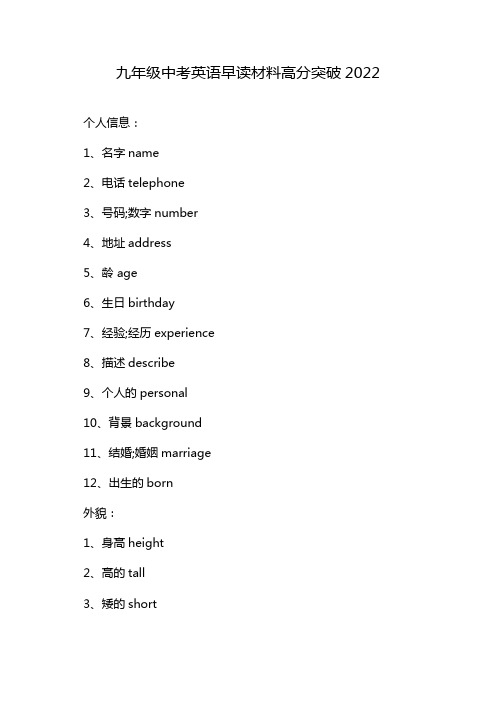
九年级中考英语早读材料高分突破2022个人信息:1、名字name2、电话telephone3、号码;数字number4、地址address5、龄 age6、生日birthday7、经验;经历experience8、描述describe9、个人的personal10、背景background11、结婚;婚姻marriage12、出生的born外貌:1、身高height2、高的tall3、矮的short4、苗条的slim5、瘦的thin6、胖的fat7、圆形的round8、英俊的handsome9、漂亮的beautiful/pretty10、丑陋的ugly11、强壮的strong12、长的old13、轻的young14、中等身材的medium- build 性格:1、外向的outgoing2、幽默的humorous3、严肃的serious4、害羞的;腼腆的shy5、安静的quiet6、诚实的honest7、活泼的lively8、勤奋的hard-working9、聪明的clever10、勇敢的brave11、懒惰的lazy12、笨的;蠢的stupid13、耐心的patient14、粗心的careless15、小心的﹔仔细的careful16、友好的friendly17、善良的kind18、卓越的;极好的excellent19、可爱的lovely/cute20、有信心的 confident21、精力充沛的energetic22、慷慨的 generous23、富有创造力的creative 职业:1、音乐家musician2、歌手singer3、艺术家artist4、演员actor/actress5、教师teacher6、医生doctor7、经理manager8、商人businessman9、警察policeman/policewoman10、司机 driver11、服务员waiter/waitress12、飞行员pilot13、农民farmer14、记者reporter15、护士nurse16、工程师engineer17、科学家scientist18、厨师cook19、军官officer20、邮递员postman21、秘书secretary22、士兵soldier23、演说家speaker24、老板boss25、总统;主席 president26、领袖;领导人leader27、牙医 dentist话题句式:1、 He is a handsome boy with large blue eyes.2、 l am fond of English best of all the subjects and I'm good at it.3、 l enjoy helping.in my daily life.4、 I am good at/do well in/interested in/fond of .5、 Good habits help me to study better.6、 I have learned not only how to make friends but also how to talk to others.7、 I want to be a... because I like...very much.8、 God helps those who help themselves.9、 Where there is a will,there is a way.10、 Hold on to your dream,it will come true one day.。
九年级高分突破英语早读材料全一册作文
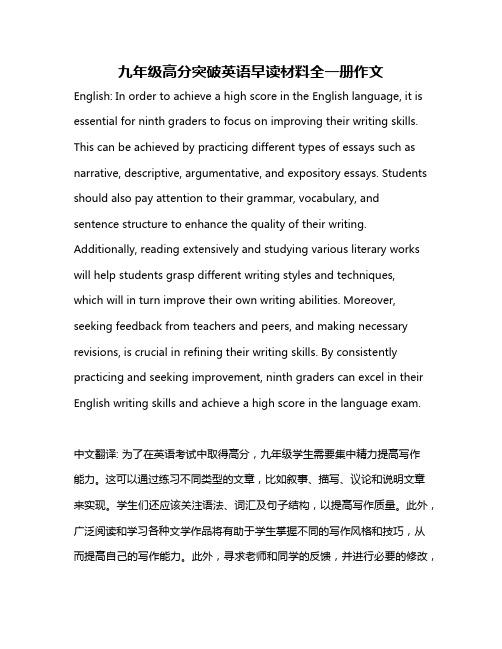
九年级高分突破英语早读材料全一册作文English: In order to achieve a high score in the English language, it is essential for ninth graders to focus on improving their writing skills. This can be achieved by practicing different types of essays such as narrative, descriptive, argumentative, and expository essays. Students should also pay attention to their grammar, vocabulary, and sentence structure to enhance the quality of their writing. Additionally, reading extensively and studying various literary works will help students grasp different writing styles and techniques, which will in turn improve their own writing abilities. Moreover, seeking feedback from teachers and peers, and making necessary revisions, is crucial in refining their writing skills. By consistently practicing and seeking improvement, ninth graders can excel in their English writing skills and achieve a high score in the language exam.中文翻译: 为了在英语考试中取得高分,九年级学生需要集中精力提高写作能力。
- 1、下载文档前请自行甄别文档内容的完整性,平台不提供额外的编辑、内容补充、找答案等附加服务。
- 2、"仅部分预览"的文档,不可在线预览部分如存在完整性等问题,可反馈申请退款(可完整预览的文档不适用该条件!)。
- 3、如文档侵犯您的权益,请联系客服反馈,我们会尽快为您处理(人工客服工作时间:9:00-18:30)。
初三英语12月8日背诵资料一背诵3a。
In 1938, a radio program by actor Orson Welles announced that aliens from Mars had landed on the Earth. He described where they had landed and told how they were moving across the United States. Welles was so convincing that hundreds of people believed the story, and panic set off across the whole country. By the time the authorities revealed that the story was a hoax, thousands of people had fled from their homes.One April Fool’s Day, a reporter in England announced that there would be no more spaghetti because the spaghetti farmers in Italy had stopped growing spaghetti. Many people ran to their local supermarket to buy as much spaghetti as they could. By the time people realized that the story was a hoax, all of the spaghetti across the country had been sold out.A famous TV star once invited his girlfriend onto his show on April Fool’s Day. He asked her to marry him. She was thrilled, because she really wanted to get married. However, when she said “yes”, he replied ”April Fool!” That little joke didn’t have a very happy ending. The TV star lost both his girlfriend and his show.二背诵下列笔记。
1 In 1938 , a radio program by actor Orson Welles announced that aliens from Mars had landed on the Earth. 解析:1)announce, 动词,意为“宣布,通告,发表,暗示着”,后接名词,代词或宾语从句。
他宣布这个名单时大家都很安静。
Everyone was silent as he announced the list.我们经理宣告说他将负责此事。
Our manager announced that he would take charge of it.堆积的乌云预示着暴风雨就要来了。
Gathering clouds announce the oncoming storm.2) land此处用作动词,意为“登陆,着陆”。
孩子们安全地登上了这个岛。
The children landed on the island safely.land还可用作名词,意为“陆地”,常用短语on land, 在陆地上。
这里的土地不适合种西红柿。
The land here is not good for planting tomatoes.2 He was so convincing that hundreds of people believed thestory, and panic set off across the whole country.解析:1)so + 形容词/ 副词+ that如此……以至于……天气太冷了,我们只好待在家里。
It is so cold that we have to stay at home.拓展:so….that 的其他常用句型:(1)so many/ few + 复数可数名词+ that从句他错的太多了,结果考试不及格。
He made so many mistakes that he failed the exam.他有这么多书要读,以至于没有时间看电视了。
He has so many books to read that he had no time to watchTV.(2) so much/ little + 不可数名词+ that从句他的钱太少了,买不起手机。
He has so little money that he cannot afford to buy a cellphone.2) convincing 形容词,意为“令人信服的”; convinced也是形容词,意为“确信的,深信的”。
他是个令人信服的演说家。
He is a convincing speaker.你认为谁最令人信服?Who do you think is the most convincing?他不久就相信自己是错了。
She was soon convinced of her error.拓展:convince 是动词,意为“使确信,使信服”。
convince sb. of sth. 让某人相信某事我无法使我叔叔明白他的错。
I couldn’t convince my uncle of his mistake.这使我相信他确实是诚实的。
This convinced me of his honest.convince sb. that 意为“让某人相信……”这使我相信他确实是诚实的。
This convinced me that he is honest.3) set off 是及物动词短语,意为“激起,引起”;他的演说激起愤怒的浪潮。
His speech set off a wave of anger.拓展:set off还有“动身,出发,启程”之意,相当于set out。
你打算明天几点钟启程?What time are you planning to set off?他们已出发环球旅行。
They’ve set off on a journey round the world.3 He asked her to marry him.解析:(1)marry是及物动词,意为“嫁,娶”,其后直接跟嫁或娶的对象.令我们惊奇的是,她将和那个比她小10岁的人结婚。
To our surprise, she is going to marry a man who is ten years younger than she.杰克过了40才结婚。
Jack didn’t marry until he was over 40.(2) be married to表“与……结婚”,注意在英语中表示这一含义时,不可说marry with。
史密斯先生的儿子娶了一个中国的女孩。
Mr. Smith’s son is married to a Chinese girl.我的朋友说我和我的工作结婚了。
(3)get married意为“结婚”。
其中get为系动词,married 为过去分词作表语。
我的父母是在1980年结的婚。
My parents got married in 1980.汤姆和安下个月将要结婚。
Tom and Ann are going to get married next month.(4)marry为非延续性动词,在表示“和某人结婚”这一状态时,且和一段时间连用时,常用be married to sb.他们已经结婚50年了。
They have been married for 50 years.(5) marry A to B表示“使A和B结婚”。
She is going to marry her daughter to a handsome young boy.4 He described where they had landed.总结:(1) describe为动词,意为“(详尽)描述,描写”。
他详尽描述了那座山。
He described the mountain in great detail.(2) 其名词形式为description. 不可数名词。
他向警察描述了失踪妇女的模样。
He gave the police a description of the missing woman.5 The TV star lost both his girlfriend and his show.Both Lily and Lucy are good at painting pictures.They both live in Nanjing.= Both of them live in Nanjing. 总结:both…and 意为“不仅……而且……;……和……都……”, 作主语时,谓语动词用复数.they both= both of them.。
